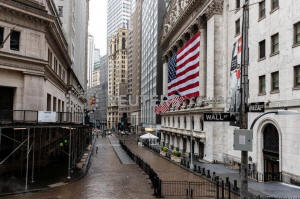Will U.S. exchange trading floors still be relevant
post-coronavirus?
 Send a link to a friend
Send a link to a friend
 [May 02, 2020] By
John McCrank [May 02, 2020] By
John McCrank
NEW YORK (Reuters) - The coronavirus
pandemic has upended U.S. equities trading with unprecedented market
volatility and forced bourses like the New York Stock Exchange to close
their trading floors, raising questions about the need for such spaces.
The NYSE, which is owned by Intercontinental Exchange Inc <ICE.N>,
closed its stock and options trading floors in New York and San
Francisco in March 23 after traders and an ICE employee tested positive
for the virus. Rivals CME Group <CME.O>, Cboe Global Markets Inc <CBOE.Z>
and Nasdaq Inc <NDAQ.O> also closed their options and futures pits in
Chicago and Philadelphia.
Despite the move to all-electronic trading, none of the exchange
operators experienced any major technical glitches amid record volumes,
and all of them reported first-quarter profits that beat analysts'
expectations.

Cboe aims to reopen its options trading floor on June 1 after
acknowledging that some customers were frustrated by the exchange's
electronic trading tools and were unable to get the most risky and
complex types of orders completed, it said on Friday.
At the same time, Chief Executive Ed Tilly said Cboe will soon roll out
new electronic solutions that will replicate benefits of the floor for
those more complex orders, prompting analysts to question the need to
reopen the spaces at all.
"Our position has always been that when our customers tell us that
there's no utility in the trading crowd, when brokers provide no service
to their customers, the electronic solution will close the trading
floor, not Cboe and not its management team," Tilly said.
[to top of second column] |

The New York Stock Exchange (NYSE) is seen in the financial district
of lower Manhattan during the outbreak of the coronavirus disease
(COVID-19) in New York City, U.S., April 26, 2020. REUTERS/Jeenah
Moon

The NYSE is the only U.S. exchange that still operates stock trading floors
alongside electronic trading. It released a study on Thursday showing that floor
traders dampen volatility by providing tighter bid-offer spreads, especially at
the market close, saving investors millions of dollars a day.
While the floor distinguishes NYSE from its competitors, the closure has not led
to a significant drop in market share, according to an analysis released Friday
by industry trade group, the Securities Industry and Financial Markets
Association.
"Only time will tell if investors feel the difference in execution of their
trades with or without the human interaction on the floor," the study said.
The NYSE plans to reopen its San Francisco-based options floor on Monday. It has
not given a date for the reopening of its iconic floors at 11 Wall Street.
CME, which runs the world's largest futures exchange, said on Wednesday it was
unclear when it would reopen its trading floors, where about 10% of its business
was done.
"We will not do anything irrational either way until we know exactly where
health officials and government officials are going to come down as far as
multiple people getting together in a single location," CEO Terry Duffy told
analysts on a call.
The closure had little effect on trading activity, CME said.
"Participants can trade any strategy today as easily as they could prior to the
closure of the floor," said Sean Tully, a senior managing director at the
exchange.
(Reporting by John McCrank; Editing by Richard Chang)
[© 2020 Thomson Reuters. All rights
reserved.] Copyright 2020 Reuters. All rights reserved. This material may not be published,
broadcast, rewritten or redistributed.
Thompson Reuters is solely responsible for this content. |